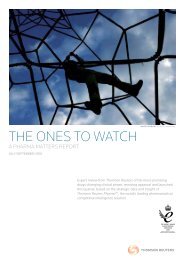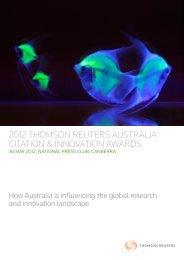THE ONES TO WATCH
The Ones To Watch - Science Australia-New Zealand - Thomson ...
The Ones To Watch - Science Australia-New Zealand - Thomson ...
- No tags were found...
You also want an ePaper? Increase the reach of your titles
YUMPU automatically turns print PDFs into web optimized ePapers that Google loves.
Staying with infectious disease, our next agent entering phase III trials is<br />
AN-2690 from Anacor, a potential topical treatment for onychomycosis,<br />
a fungal nail infection - usually of the toenail - that affects approximately<br />
35-36 million people in the US. Onychomycosis is caused by dermatophytes,<br />
fungi that infect the skin, hair or nails and involves infection of the nail plate,<br />
the nail bed and the sometimes the skin surrounding the nail. The result is<br />
discolored, thickened, brittle nails that split, are difficult to trim and make<br />
walking while wearing shoes difficult. Existing treatments for onychomycosis<br />
either have safety concerns, such as rare but serious liver toxicity in the case<br />
of oral therapies, while other topical treatments have low levels of efficacy.<br />
AN-2690 is a topical formulation that has a unique mechanism of action,<br />
inhibiting an essential fungal enzyme, leucyl transfer RNA synthetase, which<br />
is required for protein synthesis.<br />
In a phase IIa trial, 45% of patients given a 5% dose of AN-2690 had more<br />
than 2 mm of clear nail growth and a negative fungal culture, 6 months<br />
after treatment. In patients given a higher dose of the drug, 50% achieved<br />
this level of efficacy.<br />
Anacor began a phase III trial in December 2010 and results are expected in 2012.<br />
Approximately 40% of the world’s population, largely those living in the<br />
poorest countries, are at risk of malaria, a parasitic disease which causes<br />
one million deaths a year, mainly of children. Without rapid treatment,<br />
malaria cases can worsen significantly, but existing tablet formulations of<br />
antimalarial drugs can take too long to be absorbed into the bloodstream,<br />
while some patients may be suffering from gastrointestinal complications<br />
that mean they cannot swallow oral medications.<br />
ArTiMist, from Star Medical and Eastland Medical Systems, could<br />
solve this problem. The artemether-containing combination therapy is<br />
administered via a sublingual mouth spray, allowing the active ingredient to<br />
reach the bloodstream much faster and reducing the need for long stays in<br />
hospitals – lessening the burden on already overstretched health systems. It<br />
also does not require refrigeration.<br />
In November 2010, a confirmatory phase III trial was initiated in Rwanda<br />
in children up to age five with severe or complicated infections of the<br />
most dangerous malaria parasite, Plasmodium falciparum. This follows a<br />
phase II trial in which ArTiMist was comparable with WHO-recommended<br />
intravenous quinine.<br />
Finally, a potential vaccine for the treatment of renal cell carcinoma (RCC)<br />
which entered phase III trials in December 2010. IMA-901, a therapeutic<br />
intradermal vaccine comprising ten synthetic tumor-associated peptide<br />
antigens (TUMAPs) is being developed by immatics.<br />
The TUMAPs were identified using immatics’ proprietary XPRESIDENT<br />
platform which analyzes primary tumor tissue for antigens naturally present<br />
in human tumors. The TUMAPs have also been shown to activate immune<br />
cells such as cytotoxic T cells and T cells against renal cancer cells.<br />
Encouraging phase II trials in advanced RCC patients who had already<br />
failed first-line therapy found that pretreatment with a single dose of<br />
cyclophosphamide followed by IMA-901 improved survival.<br />
PHARMA MATTERS | <strong>THE</strong> <strong>ONES</strong> <strong>TO</strong> <strong>WATCH</strong>





